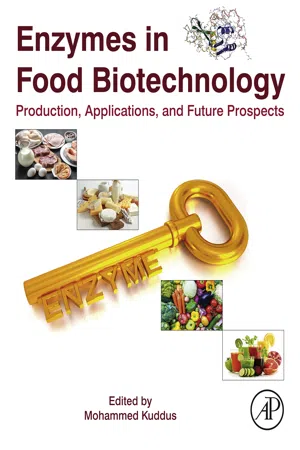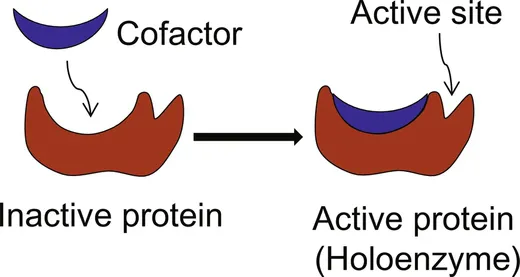
eBook - ePub
Enzymes in Food Biotechnology
Production, Applications, and Future Prospects
This is a test
- 909 pages
- English
- ePUB (mobile friendly)
- Available on iOS & Android
eBook - ePub
Book details
Book preview
Table of contents
Citations
About This Book
Enzymes in Food Biotechnology: Production, Applications, and Future Prospects presents a comprehensive review of enzyme research and the potential impact of enzymes on the food sector. This valuable reference brings together novel sources and technologies regarding enzymes in food production, food processing, food preservation, food engineering and food biotechnology that are useful for researchers, professionals and students. Discussions include the process of immobilization, thermal and operational stability, increased product specificity and specific activity, enzyme engineering, implementation of high-throughput techniques, screening to relatively unexplored environments, and the development of more efficient enzymes.
- Explores recent scientific research to innovate novel, global ideas for new foods and enzyme engineering
- Provides fundamental and advanced information on enzyme research for use in food biotechnology, including microbial, plant and animal enzymes
- Includes recent cutting-edge research on the pharmaceutical uses of enzymes in the food industry
Frequently asked questions
At the moment all of our mobile-responsive ePub books are available to download via the app. Most of our PDFs are also available to download and we're working on making the final remaining ones downloadable now. Learn more here.
Both plans give you full access to the library and all of Perlego’s features. The only differences are the price and subscription period: With the annual plan you’ll save around 30% compared to 12 months on the monthly plan.
We are an online textbook subscription service, where you can get access to an entire online library for less than the price of a single book per month. With over 1 million books across 1000+ topics, we’ve got you covered! Learn more here.
Look out for the read-aloud symbol on your next book to see if you can listen to it. The read-aloud tool reads text aloud for you, highlighting the text as it is being read. You can pause it, speed it up and slow it down. Learn more here.
Yes, you can access Enzymes in Food Biotechnology by Mohammed Kuddus in PDF and/or ePUB format, as well as other popular books in Technology & Engineering & Food Science. We have over one million books available in our catalogue for you to explore.
Information
Chapter 1
Introduction to Food Enzymes
Mohammed Kuddus Department of Biochemistry, College of Medicine, University of Hail, Hail, Saudi Arabia
Abstract
Enzymes are a biological substance that accelerates the rate of various biochemical reactions in a living organism without being used up in the reaction. The actions of enzymes are specific and biodegradable. Enzymes are involved in most of the biochemical reactions going on in microorganisms, plants, animals, and human beings. Even though enzymes are produced inside living cells, they can work actively in vitro, making them useful in industrial processes. The assimilation of enzymes in food processing is well known, and devoted research continues consistently to solve the worldwide food crisis. This chapter covers the basics of enzymes along with sources of different enzymes and their applications within various food industries.
Keywords
Enzyme; Cofactor; Enzyme action; Industrial enzymes; Food processing
Abbreviations
IUB International Union of Biochemists
IU International Units
EC Enzyme Commission
°C degree celsius
pH potential of hydrogen
ES complex enzyme substrate complex
EIS complex enzyme inhibitor substrate complex
Km Michaelis constant
Vmax maximum velocity
NAD nicotinamide adenine dinucleotide
ATP adenosine triphosphate
1.1 Enzymes
The presence of enzymes in nature have been well known for over a century. However, the first enzyme urease was isolated in crystalline form from the jack bean by James B. Sumner in 1926 (Sumner, 1926). Enzymes, also known as biocatalysts, are a biological substance that initiates or accelerates the rate of a biochemical reaction in a living organism, without itself being consumed in the reaction. Even though enzymes are produced inside the living cells, they can work actively in vitro, making them useful in industrial processes. Enzymes are complex protein molecules and are nature's own biocatalysts produced by living organisms to catalyze the biochemical reactions required to sustain life. Mostly enzymes are proteins, but not all. RNA and antibodies can also act as catalysts known as ribozymes and abzymes, respectively. The literature suggested that > 5000 biochemical reaction types are catalyzed by the enzymes (Schomburg et al., 2013). Similar to other chemical catalysts, enzymes are also highly effective in increasing the rate of biochemical reactions that otherwise proceed very slowly, or in some cases, not at all. A common example is the breakdown of foods, which includes mainly proteins, carbohydrates and fats, into their basic constituents. It is normally accomplished within 3–6 h depending on the type and amount of food. However, in the absence of enzymes, this breakdown of foodstuffs would take > 30 years. In comparison to chemical catalysts, enzymes are more specific in action and possess high catalytic properties. Also, enzymes can be immobilized on inert support material without loss of activity that facilitates their reuse and recycling.
Most enzymes, but not all, require a small molecule to perform their activity as a catalyst. These molecules are known as cofactors or coenzymes. Cofactors are non-proteinaceous chemical compounds that are bound to an inactive protein part of enzyme (apoenzyme) in order to increase the biological activity of the enzyme required for its function. The active complex of apoenzyme (protein part) along with cofactor (coenzyme or prosthetic group) is referred to as holoenzyme (Fig. 1.1). Cofactor is also considered a “helper molecule” because it assists in biochemical transformations. There are two types of cofactors: coenzymes and prosthetic groups. Coenzymes are a specific type of cofactor and are organic molecules that bind to enzymes and help in their functions. The organic molecules are simply the molecules that contain carbon. Many coenzymes are derived from vitamins. These molecules often attached to the active site of an enzyme and assist in the conveyance of a substrate or product and can also shuttle chemical groups from one enzyme to another. Importantly, coenzymes bind loosely to the enzyme but another group of cofactors do not. Prosthetic groups (organic molecules or metal ions) are also cofactors that often bind tightly to proteins or enzymes by a covalent bond. One of the significant characteristic of enzymes is their specificity for substrates or reactions they catalyze, which make them so important as a research and industrial tool. The specificity of enzymes may be of different types, such as absolute (that catalyze only one reaction), group (that act only on molecules that have specific functional groups), linkage (that act on a particular type of chemical bond) or stereo-chemical (that act on a particular steric or optical isomer).

1.2 Nomenclature and Classification of Enzymes
To date, > 6000 different types of enzymes are known (http://www.enzyme-database.org/stats.php). The names of commonly used enzymes are based on the type of reaction they catalyze followed by the suffix -ase. For example, the hydrolysis of proteins is catalyzed by proteases. There are also some trivial names for the initially studied enzymes such as trypsin, pepsin, rennin, etc. However, trivial names give no indication of source, function or reaction catalyzed by the enzyme. Thus a variety of different names have been used fo...
Table of contents
- Cover image
- Title page
- Table of Contents
- Copyright
- Dedication
- Contributors
- Foreword
- Preface
- Chapter 1: Introduction to Food Enzymes
- Chapter 2: Microbial Enzyme in Food Biotechnology
- Chapter 3: Enzymes in the Beverage Industry
- Chapter 4: Enzymes in Fruit Juice Processing
- Chapter 5: Application of Microbial Enzymes in the Dairy Industry
- Chapter 6: Wine Enzymes: Potential and Practices
- Chapter 7: Enzymes in the Animal Feed Industry
- Chapter 8: Enzymes in the Meat Industry
- Chapter 9: Enzymes for Use in Functional Foods
- Chapter 10: Enzymes as Additives in Starch Processing: A Short Overview
- Chapter 11: Lysozyme: A Natural Antimicrobial Enzyme of Interest in Food Applications
- Chapter 12: Ligninolytic Enzymes: An Introduction and Applications in the Food Industry
- Chapter 13: Hydrolases of Halophilic Origin With Importance for the Food Industry
- Chapter 14: Fungal Proteases and Production of Bioactive Peptides for the Food Industry
- Chapter 15: Application of Proteases for the Production of Bioactive Peptides
- Chapter 16: Development of Functional Food From Enzyme Technology: A Review
- Chapter 17: Current Development and Future Perspectives of Microbial Enzymes in the Dairy Industry
- Chapter 18: Enzymes for Fructooligosaccharides Production: Achievements and Opportunities
- Chapter 19: Antibiofilm Enzymes as an Emerging Technology for Food Quality and Safety
- Chapter 20: Enzyme and Bioactive Peptides—A Strategy for Discovery and Identification of Antihypertensive Peptides
- Chapter 21: Transglutaminase Cross-Linked Edible Films and Coatings for Food Applications
- Chapter 22: Application of a Novel Endo-β-N-Acetylglucosaminidase to Isolate an Entirely New Class of Bioactive Compounds: N-Glycans
- Chapter 23: Enzymatic Production of Steviol Glucosides Using β-Glucosidase and Their Applications
- Chapter 24: Enzymatic Processing of Juice From Fruits/Vegetables: An Emerging Trend and Cutting Edge Research in Food Biotechnology
- Chapter 25: Non-Saccharomyces Yeasts: An Enzymatic Unexplored World to be Exploited
- Chapter 26: Fructosyltransferases and Invertases: Useful Enzymes in the Food and Feed Industries
- Chapter 27: Nutritional and Nutraceutical Improvement by Enzymatic Modification of Food Proteins
- Chapter 28: Plant-Derived Enzymes: A Treasure for Food Biotechnology
- Chapter 29: Exploiting Microbial Enzymes for Augmenting Crop Production
- Chapter 30: Plant Growth-Promoting Microbial Enzymes
- Chapter 31: New Features and Properties of Microbial Cellulases Required for Bioconversion of Agro-industrial Wastes
- Chapter 32: Oxylipins and Green Leaf Volatiles: Application of Enzymes From Plant Origin to Produce Flavors and Antifungal Aldehydes
- Chapter 33: Role of Soil Enzymes in Sustainable Crop Production
- Chapter 34: Enzymes in Pharmaceutical Industry
- Chapter 35: Transforming the Healthcare System Through Therapeutic Enzymes
- Chapter 36: Enzymes in the Pharmaceutical Industry for β-Lactam Antibiotic Production
- Chapter 37: Enzyme Immobilization Methods and Applications in the Food Industry
- Chapter 38: Enzymes in Biosensors for Food Quality Assessment
- Chapter 39: Enzyme Engineering for Enzyme Activity Improvement
- Chapter 40: Biosensors for Food Quality and Safety Monitoring: Fundamentals and Applications
- Chapter 41: Application of Immobilized Enzymes in the Food Industry
- Chapter 42: Biosensors: An Enzyme-Based Biophysical Technique for the Detection of Foodborne Pathogens
- Chapter 43: Production of Food-Processing Enzymes From Recombinant Microorganisms
- Chapter 44: Food Enzymes and Nanotechnology
- Chapter 45: Application of Nanobiocatalysts on Food Waste
- Chapter 46: Food Enzymes From Extreme Environments: Sources and Bioprocessing
- Chapter 47: Psychrophilic Enzymes: Potential Biocatalysts for Food Processing
- Chapter 48: Enzymes Used in the Food Industry: Friends or Foes?
- Chapter 49: Future Prospectives for Enzyme Technologies in the Food Industry
- Index